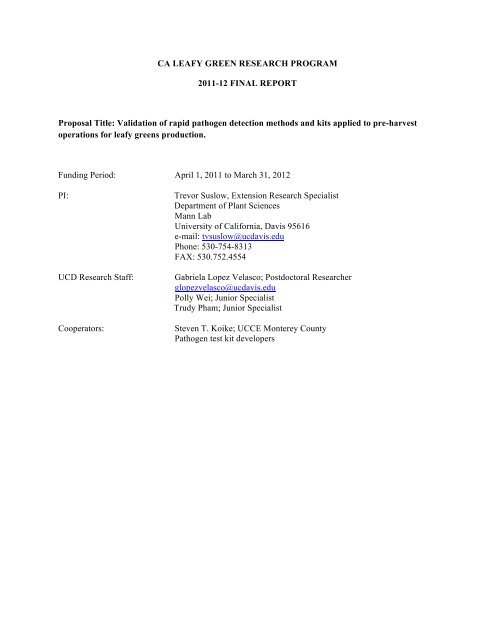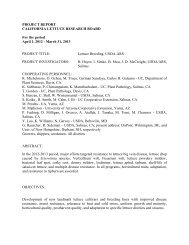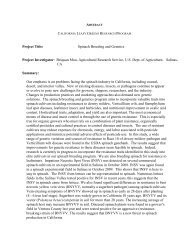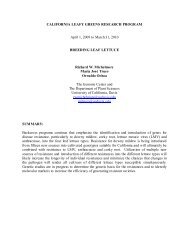Food Safety - Pathogen Detection Kits - California Leafy Greens ...
Food Safety - Pathogen Detection Kits - California Leafy Greens ...
Food Safety - Pathogen Detection Kits - California Leafy Greens ...
You also want an ePaper? Increase the reach of your titles
YUMPU automatically turns print PDFs into web optimized ePapers that Google loves.
CA LEAFY GREEN RESEARCH PROGRAM2011-12 FINAL REPORTProposal Title: Validation of rapid pathogen detection methods and kits applied to pre-harvestoperations for leafy greens production.Funding Period: April 1, 2011 to March 31, 2012PI:UCD Research Staff:Cooperators:Trevor Suslow, Extension Research SpecialistDepartment of Plant SciencesMann LabUniversity of <strong>California</strong>, Davis 95616e-mail: tvsuslow@ucdavis.eduPhone: 530-754-8313FAX: 530.752.4554Gabriela Lopez Velasco; Postdoctoral Researcherglopezvelasco@ucdavis.eduPolly Wei; Junior SpecialistTrudy Pham; Junior SpecialistSteven T. Koike; UCCE Monterey County<strong>Pathogen</strong> test kit developers
CLGRB Final Report 2011: Validation of rapid pathogen detection methods and kits applied to pre-harvest operations for leafy greens production. General description:This study was developed to better understand the factors that influence the detection ofEscherichia coli O157:H7 and Salmonella enterica on leafy greens, particularly lettuce.Environmental stress, pathogen population size, incubation time and type of enrichment,competition with other leaf microbiota as well as sample mass (leaf tissue amount per test) wereconsidered to assess the capabilities of selected molecular methods to detect these two mostcommon enteric pathogens associated with industry routine monitoring, surveillance-basedrecalls, and outbreaks.Field trials were performed during the summer and fall of 2011 at UC Davis PlantSciences Research Farm. A total of 4 types of lettuce were planted including Green Oak, GreenRomaine, Red Oak, and Lolla Rosa in order to have green and red-pigmented varieties. Eachlettuce variety was planted in a 100 ft bed which represented a plot-block, and each block/varietywas replicated in triplicate in the field, utilizing a randomized complete block distribution. Thefield was inoculated with two doses of attenuated pathogens; log 3 and log 5 CFU/mL (2L perblock), and samples were collected after 3 and 10 days of inoculation. Both attenuated bacterialisolates, PTVS155 (E. coli O157:H7) and PTVS177 (Salmonella enterica sv Typhimurium), arerifampicin resistant strains, which facilitates their recovery and identification. Both rifampicinresistantisolates retain the genetic and somatic determinants that are reactive with commercialplatforms for PCR and serological detection of each pathogen type; the exception is theattenuated E. coli O157:H7 strains which do not have shigatoxin conferring DNA sequences andtherefore give a negative result when screened for stx1 and stx2. Inoculated material washarvested and processed within 12 hours of collection. The size of the lettuce leaves was thatconsistent with mini-greens not further cut, as in use for spring mix salad blends. Collection ofthe material consisted of excising the intact leaf material above soil-line with sterile scissors anddepositing in a sterile plastic sample bag. In total, one bag of approximately 1.5 Kg of plantmaterial was collected from each block; a subsample of 25, 125 or 375 g was collected intriplicate. Thus, for each cultivar a replicated triplicate with 3 separate sub-replicates each wasanalyzed.The experiments performed during the summer of 2011 were divided in two parts. Inone, survival of both pathogens during the leafy greens production under prevailing weatherconditions was determined. In this part of the study, recovery and colony confirmation wasperformed using direct selective-plating and/or selective enrichment (all media supplementedwith 80 mg/L of rifampicin). Rifampicin is a commonly used selective agent to facilitate therecovery, quantification and detection of applied bacteria. Results from this experimental effortwere already submitted in the previous report to the <strong>California</strong> <strong>Leafy</strong> Green Research Board. Inthe second related research activity, collected samples were analyzed using enrichment withoutthe incorporation of a selective agent, thus we could evaluate recovery and detection using2
CLGRB Final Report 2011: Validation of rapid pathogen detection methods and kits applied to pre-harvest operations for leafy greens production. commercial enrichment media and kits for molecular detection. For each sample, we performedenrichment for up to 18 hours at 37 and 42 o C for S. enterica and E. coli O157:H7, respectively.The ratio of leaf sample mass to enrichment broth is indicated in each section (see below). Afterenrichment, the same sample was subjected to molecular detection and culture confirmation foreach method utilized. For culture confirmation, recover the inoculated microorganism from theprimary enrichment was greatly facilitated by amending rifampicin to the selective media,including Chromogenic agar O157 and XLT-4 for recovery of E. coli O157:H7 and Salmonella,respectively.During previous trials it was noticed that field-collected samples analyzed only throughmolecular detection resulted in predominantly negative detection outcomes, including theinternal positive controls (IPC). The IPC serves as both a positive culturable enrichment controland an internal PCR amplification control to identify the presence of interfering inhibitors to thePCR reactions. From these prior results we suspected that inhibition of the PCR reactionassociated with the plant material may have been responsible. However, this same outcome wasobserved with samples collected during summer 2011 which were all subjected to a secondaryenrichment consisting of a 4 hour incubation in 42 o C preconditioned media (Brain HeartInfusion; BHI) prior to processing for PCR detection. For samples collected during fall of 2011,with previous knowledge of potential inhibition of PCR reaction, 2 mL of enrichment werecollected and centrifuged at 14,000 rpm for 2 min, the supernatant discarded and the resultantpellet was washed twice with Butterfield’s Phosphate Buffer. The final cleaned sample wasutilized for downstream applications, including colony confirmation and molecular detection. Allresults obtained through molecular detection kits were considered negative only when the IPCwas determined to be acceptable.Results:Survival and detection of E. coli O157:H7 and Salmonella enterica on leafy greens duringfield production.A. Methods associated with standard mass: enrichment broth protocol.Samples of three lettuce types (for convenience referred to as cultivars), Green Oak,Green Romaine and Red Oak were utilized in this experiment. Subset samples of 25 g of theplant material was enriched with Brain Heart Infusion media (BHI) or Buffered peptone water(BPW) for enrichment of Salmonella and with Proprietary media A or Proprietary media B forenrichment of E. coli O157:H7. For both target pathogens a ratio of 1:10 (plant mass toenrichment broth) was used as is standard for AOAC certified test methods and commonly usedin FDA BAM protocols. Prior to introduction of the leaf mass, all enrichment media was preconditionedto 37 or 42 o C for Salmonella and E. coli O157:H7, respectively. After addition to3
CLGRB Final Report 2011: Validation of rapid pathogen detection methods and kits applied to pre-harvest operations for leafy greens production. enrichment broth, leaf material were thoroughly massaged manually and compressed into thebroth volume at the base of the sample bag to ensure the tissue was fully submerged in the brothduring incubation. Samples of the enrichment culture were collected after 4, 8, 12 and 18 h ofenrichment, except for the Media A, which was requested by the supplier to be also tested after 6h. Results obtained after 18 hours and by colony confirmation were considered as definitive tocalculate the total number of positive samples. All samples were subjected to molecular testingfor pathogen detection using a probe-based detection system, immunomagnetic-separationconcentration, and a fluorescent dye-based PCR detection system. As these studies utilized noncertifiedprotocols and to accommodate the requests of the cooperating commercial kit suppliers,all results are coded as <strong>Kits</strong> A, B, C and Z.Results A.Survival and detection of both attenuated pathogens was determined to be highly dosedependent and impacted by the duration of post-inoculation environmental exposure; greaterfrequency of detection by colony confirmation was achieved on plant material inoculated withlog 5 CFU/mL than by log 3 CFU/g and a corresponding greater number of samples were foundto be positive 3 days post inoculation as compared to 10 days (Tables 1A-B). At both inoculumdensities under the ambient conditions, quantification without subsequent processing (e.g.concentration or capture filtration) was below the limit of detection. Therefore it was necessarythat all samples be subjected to pre-detection enrichment. These results are in agreement withprevious survival and persistence experiments on the same cultivars and field location in whichdetection was performed using rifampicin as a selective agent, as well with diverse experimentsperformed by the Suslow Lab (See Background Literature). Contrasting the outcomes of the twoattenuated pathogens, the attenuated Salmonella exhibited a better environmental fitness than theattenuated E. coli O157:H7. Salmonella survival was more prevalent for both inoculation dosesand across the duration of the experiment. This observation was particularly apparent at the highinoculum dose; the frequency of positive detections remained mostly unchanged between 3 and10 days after inoculation (Table 1A). In contrast, E. coli O157:H7, at the high inoculum dose,experienced a steep drop in the rate of positive samples from 80% to about 22% (Table 1B).Samples treated with low inoculation dose were determined to result in a rapid die-off after justthree days from the time of inoculation.4
CLGRB Final Report 2011: Validation of rapid pathogen detection methods and kits applied to pre-harvest operations for leafy greens production. Table 1. Survival of (A) Salmonella enterica and (B) E. coli O157:H7 during a field study;recovery after 18 h of enrichment.(A) Low inoculum dose a High inoculum dose aDays postinoculation3 10 3 10Lettuce cultivar Total number of positive detection bGreen Oak 12 2 14 17Green Romaine 10 5 18 12Red Oak 8 1 17 14Total number ofpositive samples30 8 49 43(a)(b)(B) Low inoculum dose a High inoculum dose aDays postinoculation3 10 3 10Lettuce cultivar Total number of positive detection bGreen Oak 1 0 16 3Green Romaine 3 2 15 5Red Oak 0 0 13 4Total number ofpositive samples4 2 44 12Initial inoculation dose at the beginning of the field trial were log 3 and log 5 CFU/mL that represent low and high inoculum dosesrespectively.Positive samples correspond to samples where the attenuated pathogens were detected and confirmation through culture withrifampicin selective media after 18 h of enrichment was achieved. (n=18 samples per sampling point)Effect of time and enrichment composition in the detection of E. coli O157:H7 andSalmonella.Comparison among media showed little effect in the detection of both attenuatedpathogens, surviving following open-field inoculation, after 18 h of enrichment (Table 2). Forthe case of Salmonella, 68 and 53% of total samples were observed with BHI and BPW,respectively, while 25 and 31% of the total collected samples were positive with samplesenriched for E. coli O157 with Media A and B, respectively. Upon analyzing the resultsaccording to the duration of enrichment, it was noticed that for leafy greens inoculated withSalmonella, 12 hours of enrichment were insufficient to ensure detection in all samples bycolony confirmation that were known positive by inoculation; only slightly over 50% of thesamples were positive. In contrast, for E. coli O157:H7, after 6 h of enrichment in Media Apositive colony confirmation was observed in 96% of the samples, while with Media B between12 and 18 hours of incubation were necessary to achieve 100% positives. For both Salmonella5
CLGRB Final Report 2011: Validation of rapid pathogen detection methods and kits applied to pre-harvest operations for leafy greens production. and E. coli O157:H7, Media A and B seem to have a more selective effect that allows earlierdetection of the pathogen as compared to BHI or BPW (Table 2).Table 2. Influence of enrichment media and incubation time in the detection of Salmonellaenterica and E. coli O157:H7 from field inoculated lettuce.Brain heartinfusionSalmonellaBuffered peptonewaterMedia AE. coli O157:H7Media BTime ofenrichment (h)% of positive detection by colony confirmation a4 42 38 67 826 nd nd 96 nd8 58 51 100 8212 58 52 100 8818 100 100 100 100Ratio of positivesamples/totalsamples analyzed b 67/108 58/108 28/108 34/108(a)The percentage was based in the total number of positives that were culture confirmed after 18 hours of enrichment.Positive samples correspond to samples where the attenuated pathogens were detected and confirmation through culture withrifampicin selective media after 18 h of enrichment was achieved. Results for all inoculation levels and lettuce cultivars were pooled.(nd) not determined for this time-pointMolecular detection of both attenuated pathogens was also assessed during the timeintervals of enrichment. Samples subjected to this analysis were those treated with the higherinoculum level (log 5 CFU/mL) and collected 10 days post-inoculation. The purpose was todetermine the ability of the enrichment procedures to detect both pathogens once they have beenexposed to and survived open-field environmental stresses. Comparing results for colonyconfirmation (Table 2) with those using molecular detection (Table 3), the percentage of positivesamples was less by molecular detection than by culture confirmation after 12 hours for bothattenuated pathogens and with both molecular detection systems tested. The number of positivesamples ranged between 40-60% compared to 50-80% by culture confirmation. The outcomesrelative to the number of replicates and potential for random variability are not dramatic and arenot intended to support a suggestion that a culture-based detection approach would be a morepractical or sensitive method. It is important to reiterate that results were generated with the useof rifampicin as a selective agent so we can ensure and facilitate the recovery of the appliedstrain if it was present in the sample. However this data does provide compelling evidence thateven in pre-conditioned media, if the target bacterial pathogen has been exposed and has adaptedto environmental stress, a period of enrichment greater than 12 hours might be necessary tominimize the potential for false negative outcomes during the application of molecular detectionplatforms.6
CLGRB Final Report 2011: Validation of rapid pathogen detection methods and kits applied to pre-harvest operations for leafy greens production. Table 3. <strong>Detection</strong> of Salmonella enterica and E. coli O157:H7 through though molecularplatforms after 10 days post-inoculation exposure on lettuces in the field.(a)(b)43/54 12/54SalmonellaE. coli O157:H7Kit A Kit B Kit A Kit BTime ofenrichment (h)% of positive samples a 4 35 20 33 88 63 32 50 3312 55 38 58 42Total number ofpositivesamples/totalsamples bThe percentage was based in the total number of positives that were culture confirmed after 18 hours of enrichment from samplescollected after 10 days of inoculation with high dose of inoculum (log 5 CFU/mL)Positive samples correspond to samples where the attenuated pathogens were detected and confirmation through culture withrifampicin selective media after 18 h of enrichment was achieved. Results for all lettuce cultivars were pooled.Effect of sample mass and compositing in the molecular detection of E. coli O157:H7 andSalmonella enterica.In an effort to minimize the number of samples during product testing, it has beensuggested (and in some commercial applications put into practice without adequate validation)that by increasing the amount of leaf mass collected in each lot-acceptance test unit, thesensitivity during the detection would be enhanced while minimizing the base cost per testemployed for routine screening programs. One of the primary practical obstacles often cited forthis approach is that the ratio of plant material to enrichment broth needs to be reduced in orderto have a test sample unit that can be practically incubated and handled as incubator space maybe a limiting factor. For instance, working with samples that are 375 g (fifteen times more theusual sample size of 25 g), it would be necessary to add close to 4 L of media to maintain astandard 1:10 ratio. In this study we evaluated the use of a 1:4 ratio, based on prior reports forground beef and our own internal studies, in samples containing 375 and 125 g, which wasdetermined to be sufficient to immerse the entire amount of the plant mass. Additionally, acontrol sample containing 25 g and a 1:10 ratio of plant to enrichment media was also evaluated.The experiment was done initially with plant material that was collected from the fieldutilizing non-treated blocks, thus the collected leaf material had not been inoculated with theattenuated pathogens. Samples containing 375, 125 or 25 g were inoculated with approximately10 CFU/replicate test-unit of the attenuated strains of E. coli O157:H7 and Salmonella and storedfor 8 hours at 5 o C. Enrichment broth, pre-conditioned to the final incubation temperature, was7
CLGRB Final Report 2011: Validation of rapid pathogen detection methods and kits applied to pre-harvest operations for leafy greens production. added to the samples and aliquots of the enrichment cultures were collected after 8 and 18 hoursof incubation. Samples were analyzed by colony confirmation using rifampicin as a selectiveagent as previously mentioned, and the same sample was also utilized for detection of theattenuated pathogens using molecular detection techniques.After 8 hour of enrichment, all 375 and 125 samples were negative, while all 25 gsamples were positive by colony confirmation and molecular testing (data not shown). After 18hours of enrichment all ‘spiked’ samples were positive by colony confirmation irrespective ofthe amount of included plant mass. In contrast, 0 to 50% of the samples was negative bymolecular testing in samples containing 375 g of plant material, and about 50-100% of thesamples was positive for those containing 125 g (Table 4). Using a low challenge dose againstindigenous microbiota, this information suggests that a substantial increment in the amount ofplant material employed for a lot-qualifying or investigative detection system could be a factorthat can contribute to the frequency of false negative outcomes. These observations may be theresult of a reduced threshold number of the targeted pathogen cells after enrichment, likelyresulting from competition with background bacteria. Therefore, following manufacturerinstructions and validated or process-approved protocols for use, adhering to both the amount ofsample and the corresponding ratio with the enrichment broth, is essential.8
CLGRB Final Report 2011: Validation of rapid pathogen detection methods and kits applied to pre-harvest operations for leafy greens production. Table 4. Effect of sample size in the molecular detection of (A) E. coli O157:H7 and (B)Salmonella in leafy greens lab-inoculated prior to enrichment.MediaBBHI(A) ColonyKit BKit AconfirmationTotal number of positives/total number of samples aSample size(g)375 125 25 375 125 25 375 125 25CultivarGreen Oak 1/1 3/3 3/3 0/1 2/3 3/3 1/1 3/3 3/3Lolla Rosa 1/1 3/3 3/3 0/1 1/3 3/3 1/1 3/3 3/3Total 2/2 6/6 6/6 0/2 3/6 6/6 2/2 6/6 6/6Green Oak 1/1 3/3 3/3 0/1 3/3 2/3 1/1 3/3 2/3Lolla Rosa 1/1 3/3 3/3 0/1 0/3 3/3 0/1 3/3 3/3Total 2/2 6/6 6/6 0/2 3/6 5/6 1/2 6/6 5/6MediaBBHI(a)(B) Colony confirmation Kit B Kit ATotal number of positives/total number of samples aSamplesize (g)375 125 25 375 125 25 375 125 25CultivarGreen Oak 1/1 3/3 3/3 0/1 1/3 3/3 0/1 0/3 3/3Lolla Rosa 1/1 3/3 3/3 0/1 3/3 2/3 0/1 2/3 3/3Total 2/2 6/6 6/6 0/2 4/6 5/6 0/2 2/6 6/6Green Oak 1/1 3/3 3/3 0/1 3/3 3/3 1/1 3/3 3/3Lolla Rosa 1/1 3/3 3/3 1/1 3/3 3/3 0/1 3/3 3/3Total 2/2 6/6 6/6 0/2 3/6 5/6 1/2 6/6 5/6Results were obtained after 18 hours of enrichment. Sampling was done after 8 hours, in which samples containing 25 g of leafmaterial were positives by all detection methods. The ratio of leaf material to enrichment broth was 1:4 for 375 and 125 grams and1:10 for 25 g samples.A second trial was performed with 375 and 125 g of plant material that had beenpreviously inoculated in the field with log 3 CFU/mL and collected 48 h post-inoculation. Forthese studies, in addition to probe based <strong>Kits</strong> A and B , two other commercial kits (Kit Y and KitZ) for detection of E. coli O157:H7 and Salmonella detection kits were utilized; in all cases leafmass samples were enriched using a 1:4 ratio. <strong>Detection</strong> of the attenuated pathogens using Kit Cwhich involves immune-capture prior to molecular detection through PCR and probe based kit ZE. coli O157:H7 and Salmonella detection kits resulted in no detection for both sample mass9
CLGRB Final Report 2011: Validation of rapid pathogen detection methods and kits applied to pre-harvest operations for leafy greens production. sizes, however the IPC was unacceptable indicating inhibition of reactions even when thesamples were further processed and cleaned.In field assessments with E. coli O157:H7, recovery by culture confirmation wasobserved in 70-100% of the collected samples, however the use of molecular detection methodswith 375 g of samples resulted in 0 to 30% positive detection and 0-40% for 125 g samples(Table 5A). In each case the result was a lower rate of detection as compared to leaf materialtaken from the field and inoculated in the laboratory using standard protocols (Table 4). Theseresults underscore the importance of the physiological status of the pathogen prior to thedetection-recovery interval.Table 5A. Effect of sample mass on the molecular detection of E. coli O157:H7 in fieldinoculated leafy greens.MediaBBHI(A) Colony confirmation Kit B Kit ATotal number of positives/total number of samples aSample size(g)375 125 375 125 375 125LettucecultivarGreen Oak 3/3 6/6 0/3 0/6 0/3 1/6Green leaf 1/3 0/6 0/3 0/6 0/3 0/6Red Oak 0/2 2/6 0/2 0/6 0/3 0/6Lolla Rosa 3/3 1/6 0/3 0/6 2/3 0/6Total 7/11 9/24 0/11 0/24 2/12 1/24Colony confirmation Kit C Kit ASample size(g)375 125 375 125 375 125Green Oak 3/3 6/6 0/3 2/6 2/3 2/6Green leaf 3/3 4/4 0/2 2/4 0/3 1/4Red Oak 0/0 0/0 0/0 0/0 0/0 0/0Lolla Rosa 3/3 6/6 0/3 6/6 1/3 4/6Total 9/9 16/16 0/8 4/16 3/9 7/16In the case of samples inoculated with Salmonella there is a greater percentage ofrecovery of positive samples compared to E. coli O157:H7 which corresponds to the findingsreported in Table 1. Similar to E. coli O157:H7 outcomes, those containing 375 g had a lowerdetection rate than with 125 g (Table 5B). Different from E. coli O157:H7 detection, the Kit Aassay provided a greater number of positive observations than Kit B or Kit C system when theyare compared with the results obtained by culture confirmation (Table 5B). It is likely thatdespite a presumptively comparable population of background bacteria from field grown plants10
CLGRB Final Report 2011: Validation of rapid pathogen detection methods and kits applied to pre-harvest operations for leafy greens production. competing in the enrichment, the imposition of pre-sampling exposure and adaptation of thetarget pathogens to environmental stress factors limited the PCR-based detection.Taken collectively, these experimental outcomes point to the need for validation studydesign that incorporates the plausible physiological status and lag-growth phases of targetbacteria and sample mass size in combination with the enrichment culture volume. Ignoring anyof these variables, within the understandable objective of reducing the cost of testing andincreasing the statistical probability of detecting product defects, may inadvertently increase therisk of false negative outcomes.Table 5B. Effect of sample mass on the molecular detection of Salmonella in field inoculatedleafy greens.MediaB(B) Colony confirmation Kit B Kit ATotal number of positives/total number of samples aSample size(g)375 125 375 125 375 125LettucecultivarGreen Oak 3/3 6/6 2/3 5/6 3/3 4/6Green leaf 2/3 2/6 0/3 0/6 0/3 1/6Red Oak 2/3 5/5 1/3 0/6 0/3 0/5Lolla Rosa 3/3 4/6 1/3 1/6 1/3 1/6Total 10/12 17/24 4/12 6/24 4/12 6/24BHI(a)Colony confirmation Kit C Kit ASample size(g)375 125 375 125 375 125Green Oak 3/3 4/4 0/3 0/4 3/3 4/4Green leaf 3/3 6/6 0/3 1/6 3/3 4/4Red Oak 1/1 5/5 0/1 0/2 1/1 5/5Lolla Rosa 3/3 6/6 1/3 1/6 3/3 6/6Total 10/10 21/21 1/10 2/18 10/10 19/19Results were obtained after 18 hours of enrichment; however sampling was done after 8 hours but detection was negative for mostsamples. All internal positive controls worked adequately for molecular detection methods. Kit Z, which is a probe based moleculardetection system for both pathogens was also tested, however all outcomes were negative, potentially a result of inhibition as allinternal controls were negative.The comparison of different ratios of plant:broth material was also assessed. Fordetection of Salmonella the effect of sample mass and the ratio of plant to broth material utilizeddid not have any effect on the detection and overall, detection was achieved in more than 96% ofthe inoculated samples containing 10 CFU before enrichment (Table 6A), additionallyquantification of the population of Salmonella in the enrichment showed that regarding the11
CLGRB Final Report 2011: Validation of rapid pathogen detection methods and kits applied to pre-harvest operations for leafy greens production. conditions of enrichment employed as well as the composition of the broth, it is always possibleto achieve a population larger than log 4 CFU/mL (Table 7A), which is estimated to be sufficientto be detected using available molecular detection methods. In addition, this also suggests thatSalmonella on leafy greens could be easily enriched.In contrast, detection of E. coli O157L:H7 was highly dependent of the type of media utilized,the sample mass as well as the enrichment broth employed for its recovery and detection (Table6B), which was also supported by the final population achieved in the final enrichment (Table7B). Overall, better detection was achieved when a lower amount of sample mass is utilized incombination with a high plant:broth ratio. This strongly suggests that the presence of backgroundbacteria present on the leaf surfaces is highly competitive with E. coli O157:H7 (variability infitness and competitiveness is known among different pathogenic isolates) during the enrichmentprocess. Due to weather conditions the experiment could not be repeated using leaves inoculatedon the field. Thus, results need to be cautiously considered as it is possible that environmentalstress could add elements that favor the frequency of false negatives.12
CLGRB Final Report 2011: Validation of rapid pathogen detection methods and kits applied to pre-‐harvest operations for leafy greens production. Table 6. Effect of sample mass and ratio plant material to enrichment broth in the detection of (A) S. enterica and (B) E. coliO157:H7Sample mass (plant:broth ratio)375 (1:4) 125 (1:4) 125 (1:10) 25 (1:4) 25 (1:10)(A) Kit A KitB Kit A KitB Kit A KitB Kit A KitB Kit A KitBBPW 3/3 3/3 3/3 3/3 3/3 3/3 5/5 5/5 4/5 4/5Media B 3/3 3/3 3/3 3/3 3/3 3/3 5/5 5/5 5/5 4/5Media A 3/3 3/3 2/3 3/3 3/3 3/3 4/5 5/5 5/5 5/5BHI 3/3 3/3 2/3 3/3 3/3 3/3 5/5 4/5 4/5 5/5Totaldetected100% 92% 100% 96% 92%375 (1:4) 125 (1:4) 125 (1:10) 25 (1:4) 25 (1:10)(B) Kit A KitB Kit A KitB Kit A KitB Kit A KitB Kit A KitBTSB 2/3 3/3 3/3 0/3 3/3 0/3 5/5 5/5 5/5 5/5Media B 1/3 1/3 0/3 0/3 3/3 0/3 5/5 5/5 5/5 5/5Media A 2/3 0/3 3/3 3/3 3/3 2/3 5/5 4/5 4/5 4/5Media C 3/3 1/3 3/3 2/3 3/3 3/3 5/5 5/5 5/5 5/5Totaldetected54% 58% 71% 98% 96%Results represent total number of positives/total samples tested. Initial inoculation dose was 10 CFU for E. coli O157:H7 and samples were spiked in thelaboratory, while for Salmonella samples were inoculated in the field and they were below the limit of detection by direct plating (log 1.43 CFU/g) at the timeof collection.Results were obtained after 18 hours of enrichment; however sampling was done after 8 hours but detection was negative for most samples. All internal positivecontrols worked adequately for molecular detection methods.13
CLGRB Final Report 2011: Validation of rapid pathogen detection methods and kits applied to pre-‐harvest operations for leafy greens production. Table 7. Effect of sample mass in the final population of (A) S. enterica and (B) E. coli O157:H7 in the enrichment after 18 hour ofincubation.(A)Sample375 g 125 g 25 gmassRatio 1 : 4 1 : 10 1 : 4 1 : 10 1 : 4BHI 4.52 + 1.34 a,1 5.26 + 1.24 a,1 3.78 + 0.44 a,1 5.04 + 0.50 b,1 4.00 + 0.71 b,1BrothBPW 5.46 + 0.39 a,1 5.20 + 0.61 a,1 5.41 + 1.33 a,1 5.49 + 0.53 a,b,1 5.60 + 0.73 a,1Media B 4.35 + 1.00 a,1 4.74 + 0.31 a,1 4.67 + 0.03 a,1 4.93 + 0.30 b,1 4.44 + 0.67 a,b,1Media A 4.13 + 1.03 a,1 5.25 + 0.98 a,1,2 4.49 + 1.15 a,1,2 6.43 + 0.77 a,1 5.22 + 1.12 a,b,1,2(B)Sample 375 g 125 g 25 gmassRatio 1 : 4 1 : 10 1 : 4 1 : 10 1 : 4Media C 3.36 + 0.32 a,3 5.05 + 0.63 a,1,2 3.06 + 2.00 a,2,3 5.79 + 0.18 a,1 5.63 + 0.5 a,1BrothMedia B 1.83 + 0.62 a,2 1.69 + 0.65 c,2 2.13 + 0.09 b,2 5.25 + 0.16 a,b,1 4.70 + 0.34 a,b,1TSB 2.95 + 1.17 a,2 2.92 + 0.31 b,c,2 2.24 + 0.46 b,2 5.12 + 0.77 a,b,1 4.97 + 0.46 a,b,1Media A 2.14 + 0.49 a,2 3.91 + 0.59 a,b,1 4.29 + 0.60 a,1 4.58 + 0.30 b,1 4.40 + 0.70 b,1Results represent the mean + standard deviation in CFU/mL of enrichment (n=5). Samples were collected after 18 h and were plated on TSA supplemented with80 µg/mL of rifampicin. Different letter within the same column denote significant difference among broth tested (p
CLGRB Final Report 2011: Validation of rapid pathogen detection methods and kits applied to pre-harvest operations for leafy greens production. A statistically valid alternative strategy would be to perform the enrichment of variousstandard, validated sample mass units (25 g) and then composite the final enrichments into asingle sample for pathogen detection processing. To test this approach, we collected aliquots ofan enrichment end-point sample that was positive by culture confirmation and moleculardetection and mixed this with enrichment cultures that originated from non-inoculated plantmaterial. A total of 1 mL of each sample enrichment was mixed in a Falcon tube, homogenized,and the resultant mixture was utilized for molecular detection. Thus, an enrichment culture fromone positive sample was mixed with 3, 5 or 10 known negative samples. <strong>Detection</strong> of both E.coli O157:H7 and Salmonella was positive for all composites (Table 7). Therefore, preparationof a composite could minimize the cost of product testing without compromising the final result,assuming that the most significant cost is associated with the PCR kit and subsequent detectionprocessing.Table 7. Effect of sample pooling in the detection of E. coli O157:H7 and Salmonella onRomaine lettuce using molecular detection methods Kit AKit BMixing ratios a E. coli O157:H7 Salmonella E. coli O157:H7 SalmonellaRatio of positive samples/total analyzed composites b10:1 3/3 3/3 3/3 3/35:1 3/3 3/3 3/3 3/33:1 3/3 3/3 3/3 3/3(a)(b)Total number of negative samples:total number of positive samples. The total volume used to create the composite was of 1 mL fromeach sample.Enrichment was performed in BPW and MP media for enrichment of Salmonella and E. coli O157:H7 respectively for 18 hours with a1:10 ratio of plant material and enrichment broth. Initial inoculation dose was of 10 CFU.Effect of non-target Enterobacteriaceae in the detection of pathogenic bacteriaduring enrichment.During the sample enrichment, especially non-selective conditions, it is expected that thepopulation of non-target target microorganisms will increase. This can be avoided or minimizedby utilizing various selective agents (antibiotics, salts, acids etc.), combined with specificincubation temperatures and other selective condition strategies. Despite these semi-selective orhighly selective conditions, closely related microorganisms, part of the natural microbiota of thesample, will also be enriched, competing for resources with the target microbe and potentiallyinterfering with detection. In this study, we enriched Romaine lettuce samples that werepreviously inoculated with 10 CFU of either E. coli O157:H7 or Salmonella. In addition, samples15
CLGRB Final Report 2011: Validation of rapid pathogen detection methods and kits applied to pre-harvest operations for leafy greens production. were inoculated with l0 5 CFU of commensal E. coli, Citrobacter freundii or Enterobacteraerogenes which are taxonomically related and routinely encountered on most non-cultivatedand commercially cultivated plants, including lettuce and leafy greens. Samples were enrichedfor up to 18 hours and molecular testing was performed, as described above.Samples that were inoculated individually with each of the challenge strains but that werenot inoculated with the pathogens, as well as non-treated material, resulted in a negative outcomeafter enrichment (data not shown). Samples that contained the three enterobacteria in addition toeither E. coli O157:H7 and Salmonella, were negative in detection for most samples (Table 8).Similarly, samples containing commensal E. coli as a single challenge strain were uniformlynegative in detection using the Kit B for E. coli O157:H7, however Salmonella detection waspositive in every replicate enrichment. <strong>Detection</strong> of both pathogens in the presence of coinoculatedC. freundii or E. aerogenes was positive in all samples (Table 8). Results suggest thatsome commensal E. coli could interfere with the detection of pathogenic strains followingenrichment.16
CLGRB Final Report 2011: Validation of rapid pathogen detection methods and kits applied to pre-harvest operations for leafy greens production. Table 8. Competition assays, effect of enteric bacteria in the detection of (A) E. coli O157:H7and (B) Salmonella enterica inoculated on romaine lettuce during enrichment.(A) Microorganisms applied to the enrichment aGeneric E.coli<strong>Detection</strong> methodKit B Kit APositive samples/total samplesanalyzedC. freundii E. aerogenesE. coliO157:H7A A A A 0/3 0/3P P P A 0/3 0/3P P P P 0/3 2/3P A A P 0/3 3/3A P A P 3/3 3/3A A P P 3/3 3/3A A A P 3/3 3/3(B) Microorganisms applied to the enrichment aGeneric E.coliC. freundii E.aerogenes Salmonella<strong>Detection</strong> methodKit B Kit APositive samples/total samplesanalyzed bA A A A 0/3 0/3P P P A 0/3 0/3P P P P 1/3 2/3P A A P 3/3 3/3A P A P 3/3 3/3A A P P 3/3 3/3A A A P 3/3 3/3(a) A total of 10 5 CFU of generic E. coli¸ C. freundii and E. aerogenes and 10 CFU of E. coli O157:H7 or Salmonella were added to theenrichment. (A)=absent (P)=present(b) Enrichment was performed in BPW and media B media for enrichment of Salmonella and E. coli O157:H7 respectively for 18 hourswith a 1:10 ratio of plant material and enrichment broth.17
CLGRB Final Report 2011: Validation of rapid pathogen detection methods and kits applied to pre-harvest operations for leafy greens production. Conclusions:Molecular detection of pathogenic bacteria in produce can be impacted by several factorsincluding the duration of incubation and composition of enrichment media, sample mass andcomposition, background microbiota and the physiological status of the target microbe. Althoughthis study primarily utilized a <strong>Kits</strong> A and B pathogen detection platforms, the study was notintended to specifically compare these methods or to study their efficiency outside of thevalidated and approved test method intended for current commercial application by qualifiedlaboratories. The results of this study did fulfill the purpose of highlighting the importance ofvalidation of molecular detection platforms that include environmental conditions specific andapplicable for leafy greens. Similar studies should be performed for any commercial kits that areintended for pathogen detection across a diversity of fresh produce.AcknowledgementsWe deeply appreciate the support to the <strong>California</strong> <strong>Leafy</strong> Green Research Board for theresearch funding support.Background Literature from CLGRB funded researchGutiérrez-Rodríguez, E., A. Gundersen, A. O. Sbodio, and T. V. Suslow. 2012. Variable agronomicpractices, cultivar, strain source and initial contamination dose differentially affect survival ofEscherichia coli on spinach. J. Appl. Microbiol. 112:109–118.Tomas-Callejas, A., G. Lopez-Velasco, A. B. Camacho, F. Artés, F. Artés-Hernández, and T. Suslow.2011. Survival and distribution of Escherichia coli on diverse fresh-cut baby leafy greens underpreharvest through postharvest conditions. Int. J. <strong>Food</strong> Micobiol. 151:216–222.18









